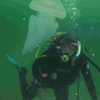General Description
Usually seen as a colony of smaller individuals (zooids) that is very long and shaped like a hollow cylinder, closed at one end. Each zooid is enclosed in a pointed test and lined up in parallel rows in the colony. Colony is opaque and colourless, pale yellow, pinkish or pinkish brown. Colony walls about 2 cm thick. Colony up to 60 cm long.
Biology
Salps feed by filtering water through their body to catch a meal of tiny plankton.
Habitat
Open water, near surface to depth of 500 m.
Open water
Distribution guide
Worldwide.
Species Group
Jellyfishes and allies › Salps
Depth
Shallow (1-30 m)
Deep ( > 30 m)
Water Column
Max Size
60 cm
Diet
Plankton or Particles
Harmful
Not known to be dangerous to humans.
Commercial Species
No
Global Dispersal
Recorded in Australia
Identify
Conservation Status
- DSE Advisory List : Not listed
- EPBC Act 1999 : Not listed
- IUCN Red List : Not listed





